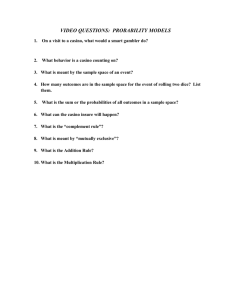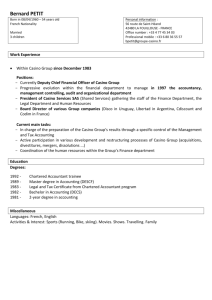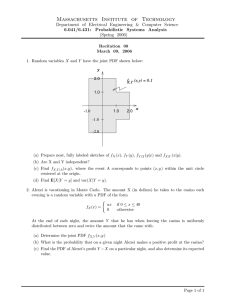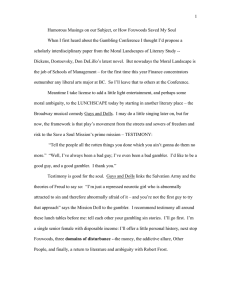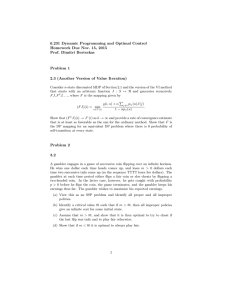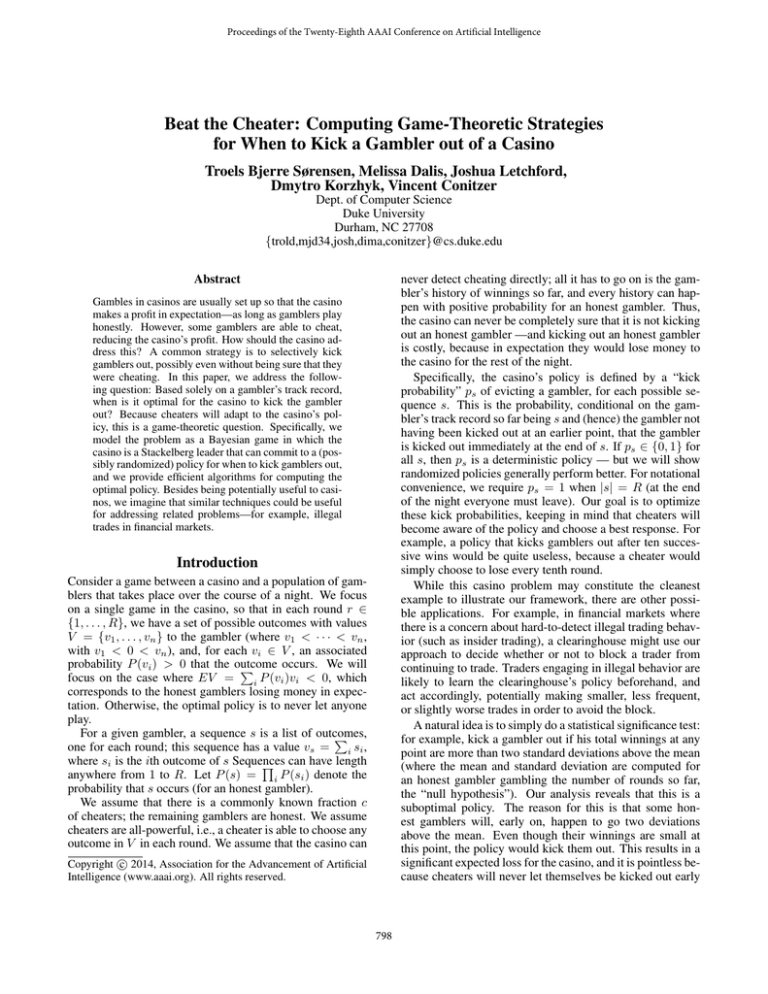
Proceedings of the Twenty-Eighth AAAI Conference on Artificial Intelligence
Beat the Cheater: Computing Game-Theoretic Strategies
for When to Kick a Gambler out of a Casino
Troels Bjerre Sørensen, Melissa Dalis, Joshua Letchford,
Dmytro Korzhyk, Vincent Conitzer
Dept. of Computer Science
Duke University
Durham, NC 27708
{trold,mjd34,josh,dima,conitzer}@cs.duke.edu
Abstract
never detect cheating directly; all it has to go on is the gambler’s history of winnings so far, and every history can happen with positive probability for an honest gambler. Thus,
the casino can never be completely sure that it is not kicking
out an honest gambler —and kicking out an honest gambler
is costly, because in expectation they would lose money to
the casino for the rest of the night.
Specifically, the casino’s policy is defined by a “kick
probability” ps of evicting a gambler, for each possible sequence s. This is the probability, conditional on the gambler’s track record so far being s and (hence) the gambler not
having been kicked out at an earlier point, that the gambler
is kicked out immediately at the end of s. If ps ∈ {0, 1} for
all s, then ps is a deterministic policy — but we will show
randomized policies generally perform better. For notational
convenience, we require ps = 1 when |s| = R (at the end
of the night everyone must leave). Our goal is to optimize
these kick probabilities, keeping in mind that cheaters will
become aware of the policy and choose a best response. For
example, a policy that kicks gamblers out after ten successive wins would be quite useless, because a cheater would
simply choose to lose every tenth round.
While this casino problem may constitute the cleanest
example to illustrate our framework, there are other possible applications. For example, in financial markets where
there is a concern about hard-to-detect illegal trading behavior (such as insider trading), a clearinghouse might use our
approach to decide whether or not to block a trader from
continuing to trade. Traders engaging in illegal behavior are
likely to learn the clearinghouse’s policy beforehand, and
act accordingly, potentially making smaller, less frequent,
or slightly worse trades in order to avoid the block.
A natural idea is to simply do a statistical significance test:
for example, kick a gambler out if his total winnings at any
point are more than two standard deviations above the mean
(where the mean and standard deviation are computed for
an honest gambler gambling the number of rounds so far,
the “null hypothesis”). Our analysis reveals that this is a
suboptimal policy. The reason for this is that some honest gamblers will, early on, happen to go two deviations
above the mean. Even though their winnings are small at
this point, the policy would kick them out. This results in a
significant expected loss for the casino, and it is pointless because cheaters will never let themselves be kicked out early
Gambles in casinos are usually set up so that the casino
makes a profit in expectation—as long as gamblers play
honestly. However, some gamblers are able to cheat,
reducing the casino’s profit. How should the casino address this? A common strategy is to selectively kick
gamblers out, possibly even without being sure that they
were cheating. In this paper, we address the following question: Based solely on a gambler’s track record,
when is it optimal for the casino to kick the gambler
out? Because cheaters will adapt to the casino’s policy, this is a game-theoretic question. Specifically, we
model the problem as a Bayesian game in which the
casino is a Stackelberg leader that can commit to a (possibly randomized) policy for when to kick gamblers out,
and we provide efficient algorithms for computing the
optimal policy. Besides being potentially useful to casinos, we imagine that similar techniques could be useful
for addressing related problems—for example, illegal
trades in financial markets.
Introduction
Consider a game between a casino and a population of gamblers that takes place over the course of a night. We focus
on a single game in the casino, so that in each round r ∈
{1, . . . , R}, we have a set of possible outcomes with values
V = {v1 , . . . , vn } to the gambler (where v1 < · · · < vn ,
with v1 < 0 < vn ), and, for each vi ∈ V , an associated
probability P (vi ) > 0 that the outcome
occurs. We will
P
focus on the case where EV =
i P (vi )vi < 0, which
corresponds to the honest gamblers losing money in expectation. Otherwise, the optimal policy is to never let anyone
play.
For a given gambler, a sequence s is a list of outcomes,
P
one for each round; this sequence has a value vs = i si ,
where si is the ith outcome of s Sequences
Q can have length
anywhere from 1 to R. Let P (s) = i P (si ) denote the
probability that s occurs (for an honest gambler).
We assume that there is a commonly known fraction c
of cheaters; the remaining gamblers are honest. We assume
cheaters are all-powerful, i.e., a cheater is able to choose any
outcome in V in each round. We assume that the casino can
c 2014, Association for the Advancement of Artificial
Copyright Intelligence (www.aaai.org). All rights reserved.
798
not uncommon that linear programs are exponential for security games, e.g., [Jain, Conitzer, and Tambe, 2013]. Even
when the normal form is exponential in size, in some cases,
an alternate formulation can be used such as the extensive
form. This doesn’t help in our case, as even the extensiveform formulation of our problem has an exponential number
of nodes (in the number of rounds). Additionally, our formulation has both random moves and imperfect information.
It has been shown that either of these individually would
be sufficient to make the problem NP-hard [Letchford and
Conitzer, 2010].
in response to this policy, since later on they can accumulate
much larger winnings. On the other hand, a modified policy that only checks later on whether someone is above two
standard deviations is vulnerable to a cheater accumulating
large winnings early on.
Expert [Littlestone and Warmuth, 1994; Cesa-Bianchi et
al., 1997] and bandit [Auer et al., 2002; Gittens, 1979] algorithms may also appear to be relevant; however, using
them across rounds for a single gambler does not work, because once we kick a gambler out, we cannot let the gambler
gamble again in a later round. We could use them across
gamblers, letting each expert or bandit arm correspond to a
policy and learning the optimal one by experimenting with
many gamblers in sequence. Downsides of this include that
it does not incorporate prior information, it does not give
insight into the structure of optimal policies, and, perhaps
most importantly, without further analysis the policy space
appears too complex for this to work well.
Optimal stopping problems, such as the well-known secretary problem [Freeman, 1983], are another class of apparently related problems that would at least capture the fact
that kicking a gambler out is an irreversible decision. However, we are not aware of any optimal stopping problems
that are game-theoretic in nature (other than to the extent
that they optimize for the worst case and in that sense are
adversarial in nature). More generally, what appears to set
our problem apart is that it is fundamentally a problem in
game theory. We are not concerned with judging whether a
gambler is a cheater per se, which might be the natural goal
from a statistics viewpoint, but rather with maximizing the
casino’s profit in the face of some cheaters. Moreover, the
problem is fundamentally not zero-sum: for example, throwing everyone out in the first round leaves both the casino and
the cheaters worse off than the optimal solution. (The honest
gamblers are not strategic players.)
Computing the optimal policy
In this section, we show how to compute the optimal policy
for the casino. It is possible to solve small instances of the
problem using linear programming. While this provides a
direct solution to the problem, it is practically infeasible for
solving anything but small toy examples. This is due to the
fact that both the number of variables and the number of constraints are exponential in R, with a variable per probability
in the policy and a constraint per sequence. We therefore
now proceed to define the optimal policies in a more concise way, and prove that they are indeed optimal.
As we shall see shortly when we formalize everything,
the optimal policy is completely characterized by how much
a cheater is allowed to win in expectation. This amount
we will call the casino’s initial goodwill towards a gambler,
which we in general denote by g. By updating this value according to wins and losses as the night progresses, the casino
keeps track of how much more the gambler can be allowed
to win in expectation. If the gambler wins, his goodwill goes
down by the amount won, and if he loses, it goes up by the
amount lost. If a gambler runs out of goodwill, he will be
kicked out of the casino for sure. If a gambler’s goodwill
gets dangerously low, the casino can raise his goodwill by
kicking him out with some probability. This may sound a
little strange, but remember that the goodwill represents how
much we allow a cheater to win in expectation. By kicking
the gamblers with history s out with probability ps < 1,
we can allow those that are not kicked out to win a factor 1/(1 − ps ) more, and still provide the same guarantee
in expectation against cheaters. As we shall see shortly, if
the goodwill is less than vn , the optimal kicking probability
raises the goodwill so that it becomes equal to vn , and if the
goodwill is at least vn , we do not kick at all.
We now formally define both goodwill and optimal policies. Since the optimal policy is defined from goodwill, the
following definition of goodwill already has the policy substituted in:
Definition 1 (Goodwill). Given an initial amount of goodwill, G ≥ 0, the goodwill towards a gambler with history s
is given by g(s, G):
Related work
This paper fits naturally into a recent line of work on applying algorithms for computing game-theoretic solutions
to security scenarios. These applications include allocating
security resources across terminals in the Los Angeles International Airport, assigning Federal Air Marshals to commercial flights, choosing patrol routes for the U.S. Coast Guard
to protect ports, detecting intrusion in access control systems, and so on [Alpcan and Basar, 2003; Kiekintveld et al.,
2009; Pita et al., 2008; Tsai et al., 2009]. In these applications, as in ours, the player in the defensive role is modeled
as a Stackelberg leader who commits to a randomized strategy, to which the player in the attacking role then responds.
In these applications, generally an argument can be made
that the attacker would have an opportunity to learn the defender’s strategy before attacking, which justifies the Stackelberg model; additionally, the Stackelberg model has technical advantages. It avoids the equilibrium selection issues
of concepts like Nash equilibrium, and we can solve for an
optimal strategy for the leader in time that is polynomial in
the size of the normal form of the game [Conitzer and Sandholm, 2006; von Stengel and Zamir, 2010]. However, it is
g(∅, G) = G
g(s.v, G) = max(g(s, G), vn ) − v
(1)
(2)
where s.v is the composition of the history s with the outcome v at the end.
and we immediately define the corresponding policy as:
799
g ≥ vn , we have that
X
h(g, r + 1) =
P (v) · (h(g − v, r) − v)
Theorem 1. The following policy, pG , maximizes the
casino’s expected utility against the honest gamblers, under
the constraint of limiting the loss against cheaters to at most
G:
pG,s = max(0, 1 − g(s, G)/vn )
(3)
≥
g
(8)
(9)
Again, since this also holds for g = vn , and h(g, r) and
h(g, r + 1) are linear in g for g ∈ [0; vn ], we have that
h(g, r + 1) ≥ h(g, r) for all g, which concludes the
proof.
We also need the following lemma:
Lemma 3. For any fixed r, the function h(g, r) is concave
in g.
Proof. The proof goes by induction on r. The base case is
r = 0, for which h(g, r) = h(g, 0) = 0 by definition, so the
statement trivially holds. Now assume for induction that the
statement holds for r −1. There are three cases in this proof;
one for each of g < vn , g > vn , and g = vn .
case g < vn :
In this case, we have that h(g, r) = g/vn · h(vn , r), i. e. , a
linear function in g, and it is trivially concave.
case g > vn :
P
In this case, h(g, r) = v∈V P (v) · (h(g − v, r − 1) − v).
Since h(g, r − 1) is concave for all g by induction, so is
h(g − v, r − 1) − v. Thus h(g, r) is a linear combination of
concave functions, and is therefore concave.
case g = vn :
The function is only semi-differentiable at vn , so to prove
concavity, we have to prove that the right derivative is not
greater than the left derivative.
∂+
∂+ X
h(g, r) =
P (v) · (h(g − v, r − 1) − v) (10)
∂g
∂g
v∈V
X
∂+
=
P (v) ·
h(g − v, r − 1)
(11)
∂g
v∈V
X
≥
P (v) · h(vn , r − 1)/vn
(12)
(4)
Proposition 1. The expected utility to the casino using the
policy defined in Theorem 1, over the remaining r rounds,
against an honest gambler with remaining goodwill g is
given by:
if r = 0
0, P
g
h(g, r) = P
v∈V P (v) · (h(vn − v, r − 1) − v), if g < vn
vn
otherwise
v∈V P (v) · (h(g − v, r − 1) − v),
(5)
v∈V
We need to prove a few lemmas about h(g, r), before we
can prove that the policy used to compute it is optimal. First,
we need a lemma that says that with more rounds, the casino
can get more money from the honest gamblers:
≥ h(vn , r)/vn =
∂−
h(g, r)
∂g
(13)
The bound at (12) is due to h(vn , r −1)/vn being the derivative of h(g, r − 1) for g ∈ (0; vn ). This works as an upper
bound on the derivative, since it is the leftmost part of the domain, and the function is concave. The bound at (13) is due
to Lemma 2. Thus, the function is also concave at g = vn .
Thus the induction hypothesis holds for r, which concludes
the proof.
Lemma 2. For any fixed g, the function h(g, r) is nondecreasing in r. Formally: h(g, r + 1) ≥ h(g, r).
Proof. The proof goes by induction on r. The base case
is r = 0, for which h(g, r) = h(g, 0) = 0 by definition.
Furthermore, for g ≥ vn , we have that
X
P (v) · (h(g − v, r − 1) − v)
= h(g, r)
The base case for h(g, r) is when there are no rounds left.
In that case, the casino closes, and no one wins any more.
Hence, h(g, 0) = 0. Similarly, if we cannot allow a cheater
to win anything, we have to kick everyone out, so no one
wins any more, and h(0, r) = 0. In all other cases, we can
express h(g, r) in terms of h(·, r − 1) by letting the honest
gambler play for another round, while reducing the expected
winning by a factor equal to the probability of not being immediately kicked out by the policy. That gives the following
recurrence:
h(g, 1) =
X
v∈V
That is, the kicking probability is 1 when there is 0 goodwill, 0 when there is at least vn goodwill, and it varies linearly between 1 and 0 in the interval [0, vn ].
To prove the theorem, we will first construct an expression, h(g, r), which captures how much the casino wins in
expectation from an honest gambler over the remaining r
rounds, by using the policy defined in Theorem 1 for sequences with g remaining goodwill. We will then prove
that no policy can win more from the honest gamblers, without letting cheaters win more than g in expectation, thereby
proving Theorem 1. Thus, h(g, r) captures the trade off between earnings on the honest gamblers and losses on the
cheaters. Once this is established, the casino’s optimization
problem becomes:
max{(1 − c) · h(g, R) − c · g}
(7)
v∈V
P (v) · (h(g − v, 0) − v) = −EV > 0 = h(g, 0)
We are now ready to prove the main theorem.
v∈V
Proof of Theorem 1: First, we prove that no policy can kick
a gambler out with a lower probability than what the theorem
prescribes, and still guarantee than a cheater gets no more
than g. This follows almost directly from the definition. If
(6)
Since this also holds for g = vn , and h(g, r) is linear in
g for g ∈ [0; vn ], we have that h(g, 1) ≥ h(g, 0) for all g.
Now, assume for induction that h(g, r) ≥ h(g, r − 1). For
800
the current goodwill is at least vn , then the policy prescribes
kicking with probability 0, so it is only relevant to look at
g < vn . In this case, if a policy were to kick with a probability lower than 1−g/vn , then a cheater can get more than g
in expectation, by immediately choosing outcome vn . Thus,
the policy in Theorem 1 provides a lower bound on kicking
probabilities that guarantee to limit cheaters to winning at
most g.
Secondly, we need to prove that among such “loss limiting” policies, the one guaranteeing the highest utility against
honest gamblers is exactly the policy from Theorem 1. We
prove this by induction on r. The base case is r = 0, for
which there is only one possible policy. Assume for induction that the policy from Theorem 1 is optimal with r − 1
rounds left. This means that h(g, r−1) has the optimal value
over all policies. For any given g, we can decide to kick
with a higher probability with r rounds left. Since h(g, r)
captures what we get by kicking with the lowest allowed
probability, we can express our optimization problem as:
max {(1 − p) · h(g/(1 − p), r)}
p∈[0,1)
induction, this can only happen at a point in M . By definition of M , if g − v is in M , then so is g. Thus h(g, r) can
only have end-points in M . Since this holds for g ≥ vn , and
h(g, r) is linear in g for g ∈ [0; vn ], the lemma holds for all
values of g.
This means that we can focus on computing the values of
h(g, r) for g ∈ M . Furthermore, we do not need to compute
it for g ≥ r · vn , since that is more goodwill than a gambler
can lose on the remainder of the game, and thus h(g, r) =
−EV · r. We can thus construct a table of the values of
h(g, r) for g ∈ M ∩ [0, Rvn ] and r ∈ {1, . . . , R}. This table
has R2 vn /gcd (V ) entries, each requiring O(|V |) work. See
the experiments section for estimates of constants.
Deterministic policies
In general, optimal policies require the use of randomization, but in some cases, the optimal policies will always be
deterministic. The deciding factor is the structure of the set
of outcomes, V .
(14)
Definition 2 (Inverse jackpot). A set of outcomes, V , is
called an inverse jackpot if
where p represents an additional probability of kicking, before reverting to the policy from Theorem 1. We can exclude
the special case p = 1, since this kicks everyone out, guaranteeing an outcome of 0, which cannot be optimal for g > 0.
The expression in (14) is maximized at p = 0, since:
h(g, r) = h(p · 0 + (1 − p) · g/(1 − p), r)
≥ p · h(0, r) + (1 − p) · h(g/(1 − p), r)
= (1 − p) · h(g/(1 − p))
V ⊆ {vn · z | z ∈ Z} ,
(18)
i.e., gcd (V ) = vn .
In other words, all outcomes other than vn are some nonpositive integer multiple of vn ; you either win a little, or lose
big. Inverse jackpots distinguish themselves by the following property:
(15)
(16)
(17)
Corollary 1. If the set of outcomes is an inverse jackpot,
then there is a deterministic policy that is optimal.
The first equality is valid, since p 6= 1. The second is
Jensen’s inequality, since h(g, r) is concave in g. The last
equality is due to the fact that h(0, r) = 0. Thus, the optimal
additional kick probability is 0, meaning that the minimal
kicking probability prescribed by Theorem 1 is optimal.
Proof. The first part follows directly from Lemma 4, which
implies that optimal goodwill is an integer multiple of vn for
inverse jackpots, and therefore so is the resulting goodwill of
all sequences. By Theorem 1, all kicking probabilities will
either be 0 or 1.
With Theorem 1 proven, we know that h(g, r) exactly
captures the tradeoff between the casino’s earnings on honest gamblers versus how much they lose to the cheaters.
Gambles that are not inverse jackpots will not admit optimal deterministic policies, for any sufficiently large R, assuming P (vn ) < 1 and EV < 0, but we will not prove that
here.
It is possible to find the optimal deterministic policy, using the same techniques as for randomized policies from the
previous section. The calculating differs in two places. Most
importantly, restricting p to be either 0 or 1 in the definition
of h leads to the following form:
Computing optimal initial goodwill
From the previous section, we know that we can focus on
computing h(g, r). We can do this efficiently using dynamic
programming by using the following lemma:
Lemma 4. h(g, r) is a piecewise linear function in g, with
end-points in M = {k · gcd (V ) | k ∈ N0 }, where gcd(V ) is
the greatest common divisor of the vi ’s. The optimal goodwill is therefore also to be found in the set M .
0,
hd (g, r) = P
Proof. The proof goes by induction on r. The base case,
r = 0, is trivially satisfied, as h(g, 0) = 0. Assume for induction that theP
lemma holds for r − 1. For g ≥ vn , we have
that h(g, r) = v∈V P (v) · (h(g − v, r − 1) − v). This is
a weighted average of piecewise linear functions with endpoints in M . Therefore h will also be a piecewise linear
function. Furthermore, it will only have an end-point, whenever one of the terms h(g − v, r − 1) is at an end-point. By
v∈V
if r = 0 or g < vn
p(v) · (h(g − v, r − 1) − v), otherwise
(19)
Secondly, the cheater’s utility against the deterministic policy derived from goodwill G is not necessarily G, as this
requires the existence of a sequence s of outcomes of length
at most |R| with at least one vn and val(s) = G. This
can either be solved directly, or the reachable utilities can
be computed by dynamic programming.
801
Approximating the optimal policy
where N is the cumulative distribution function of
the stan2
dard normal distribution. In other words, P µ,σ (t, λ) expresses the probability that an honest gambler has not been
kicked out at time t. That means that the expected rate at
which the casino is getting money at time t from an honest
2
gambler is −µP µ,σ (t, λ). The expected winnings over the
entire evening is the integral of the rate:
Z T
2
H(λ, T ) =
−µP µ,σ (t, λ)
(27)
The previous section made several assumptions that might
not fit the problem at hand. It might be the case that R is
too large for it to be feasible to compute the table for the
dynamic program, or it might be that vn /gcd (V ) is prohibitively large. Slightly more obscure, if V is not given as
rational numbers, it might be the case that √
V does not have
a greatest common divisor, e.g., if V = {− 2, 1}. It would
still be possible to do a similar dynamic programming approach, but the table would in general be exponentially large
in the number of such independent vi ’s, which is worst case
all of |V |.
We therefore turn our attention to approximations. If the
number of rounds is large enough, the gambling of an honest
gambler can be approximated by a Brownian motion with
drift [Durrett, 2010]. We can use this to approximate the
optimal initial goodwill for a randomized policy.
t=0
2
Because of the N terms in the expression for P µ,σ (t, λ),
this has to be evaluated numerically, which can be done to
high precision by most mathematics software. In the experiments section, we used Mathematica for the task.
The value of this integral, H(λ, T ), gives the amount that
an honest gambler is expected to lose over time length T ,
when gamblers are kicked out at any time they have won λ.
It thus plays the same role as h(g, r) in the discrete case. A
cheater will just get λ. The casino is therefore interested in
optimizing:
Continuous time
If the game is continuous over a period of time with very
small and frequent gambles, we can use Brownian motion
to find the optimal threshold at which to kick out a gambler.
Define Sn as the total earnings up to game n, τ as the stopping time when the gambler gets kicked out of the casino,
and T as the final time the gambler could keep playing until if he never gets kicked out. Let X n be the outcome of
the nth game for an honest gambler. We know that X n is
normally distributed as follows:
max{−c · λ + (1 − c) · H(λ, T )}
λ
(28)
This expression is concave in λ, so it can be maximized
by a simple ternary search, evaluating H numerically at each
step. In the next section, we evaluate using optimal λ as the
input to the policy defined by Theorem 1.
Experiments
µ σ2 ,
(20)
n n
Thus the sum of the earnings from time 1 to n is given as:
n
X
Xi ∼ N (µ, σ 2 )
(21)
Xn ∼ N
In this section we provide the results of experiments that
compare the casino utilities from different kicking policies,
and the scalability of the linear and dynamic programs. We
use an example game in which the gambling population consists of 30% cheaters and 70% honest gamblers. The game
is played for R rounds and has K = |V | outcomes, each of
which are chosen uniformly at random from [−2000, 1000],
with P (v) = 1/K for all outcomes.
i=1
Then, summing over time 1 to n and games 1 to t, we get
that for t ∈ Z
t X
n
µnt σ 2 nt X
n
Stn =
Xj,i
∼N
,
= N (µt, σ 2 t)
n
n
j=1 i=1
Casino utility
First, we consider how the casino utility compares between
the different kicking algorithms for K = 100, and R =
{10, 20, ..., 100}.
The performance of the different policies can be seen in
Figure 1. All performances are relative to the optimal randomized policy, which is the top-most line. Just below,
barely distinguishable from optimal, is the randomized policy with goodwill derived from the Brownian motion model.
On all data points, it is above 99.9% of optimal. The third
line from the top is how much Brownian motion underestimates the true optimal utility, and it is thus not a performance of a kicking policy. The fourth line is the optimal
deterministic kicking policy. Finally, the last line is the deterministic policy with goodwill derived from the Brownian
motion.
Unsurprisingly, both the deterministic and randomized
policies result in greater casino utility by using the calculated goodwills from those policies rather than the Brownian
motion approximation of the optimal goodwill. However, as
(22)
ztn
We define the standard normal variable
as:
Xtn − Etn
ztn = p
(23)
var(Stn )
To model this as a Brownian motion with drift, we get
√
√ n
Stn
µt
t(Xtn − Etn )
√
tzt =
=
−
(24)
σ
σ
σ t
So the probability that an honest gambler has not won
more than a given limit λ by time t is
P (τλ > t) = 1−P (τλ ≤ t) = 1−P (zi ≤ λ, ∀i ≤ t) (25)
The probability density function [Herlemont, 2009] is
given as follows
λ − µt
2µλ
−λ − µt
µ,σ 2
√
√
P
(t, λ) = N
− exp
N
σ2
σ t
σ t
(26)
802
Summary and future work
We modeled the casino’s optimal policy for maximizing its
earnings by limiting the impact of cheaters, assuming that
the cheaters have full control over the outcome of the game.
We presented a dynamic programming approach, which efficiently computes the casino’s optimal policy by finding the
optimal initial goodwill. It is easy to execute the policy
based on goodwill of a gambler; subtract his winnings from
his goodwill. If his goodwill drops below vn , kick him out
with probability 1 − goodwill/vn . If he wasn’t kicked out,
round his goodwill up to vn and let him continue gambling.
This runtime of the dynamic program is linear in the number
of outcomes and quadratic in the number of rounds.
A special case for this repeated game is when gambles
are small enough that the casino’s and gambler’s utility is
smoother. In this case, we can use Brownian motion to
calculate an honest gambler’s expected earnings in order to
efficiently approximate the optimal kicking policy for the
casino. This Brownian motion will have negative drift since
an honest gambler’s expected utility is negative if the casino
is profitable. We showed how to use this Brownian motion
model to quickly get a very good approximation of the optimal initial goodwill. Since the goodwill defines the policy,
an approximation translates to an easy to execute policy.
We exploited the casino’s power of evicting cheaters from
the casino when it reaches our policy’s threshold. But there
are also other ways for the casino to strategize so that the
cheater doesn’t always cheat. For example, instead of deciding simply whether or not to kick a cheater out, the casino
might also decide to perform an investigation on a gambler
that comes with a cost as well as a probability that the investigation provides the correct conclusion about a gambler. In
other domains such as catching insider trading, performing
investigations might be more reasonable than without evidence stopping a trader from continuing to trade.
Future work should also be done to break down some of
the assumptions in this paper about the cheaters and the honest gamblers. Rather than a cheater that has complete control
over the outcome of the game, we could have cheaters that
only have some control over the game. In this case, there
might be different types of cheaters whose probability of a
win comes from different distributions, depending on how
successful of a cheater he can be. Another assumption was
gamblers would never choose to leave the casino, and that
they only leave if the casino kicks them out, or when the
casino closes for the night. However, it might be more realistic that honest gamblers are willing to continue playing
until they lose a certain amount of money, at which point
they might leave to cut their losses.
We also want to apply this framework to other scenarios in
which the leader has the power to end the game at any point
in order to disincentivize an adversary. One could apply this
to financial markets in which clearinghouses or policy makers want to reduce the frequency and size of insider trading. When a trader reaches a certain threshold that an honest
trader would likely never reach, security may want to prevent the trader from continuing to trade. This is much like
the framework presented in this paper in which the casino
wants to prevent cheaters from winning too much.
Figure 1: Casino Utility for Randomized, Deterministic, and
Brownian Motion-approximated kicking policies
Figure 2: Scalability in number of rounds
the number of rounds increases, the random and deterministic policies result in increasingly similar casino utilities.
The randomized policy with the Brownian motion approximated goodwill becomes very slightly worse as the number
of rounds increases, and the deterministic policy with Brownian motion approximated goodwill improves significantly.
The benefit of using the Brownian motion approximation is
that the ternary search with numerical integration is much
faster to compute than the full dynamic program.
Efficiency of computation
We ran performance tests on the LP approach as well as
the dynamic programming approach. The LP approach was
evaluated for two outcomes, for which it becomes impractical to solve for R ≥ 16. Performance would be worse
for more outcomes. The dynamic program was tested with
K, R ∈ {10, 20, . . . , 100}. Each of the 100 combinations were timed as an average over 10 runs. We found
time = 50.49 + 0.01132 · K · R2 . The p-value of this model
less than 2.2e − 16, and the adjusted R-squared is 0.9894.
803
Acknowledgements
We would like to thank the helpful comments of the AAAI
anonymous reviewers. We would also like to thank Prof. Susan Rodger for useful feedback on a previous version of
the paper. We thank ARO and NSF for support under grants W911NF-12-1-0550, W911NF-11-1-0332, IIS0953756, CCF-1101659, and CCF-1337215.
References
Alpcan, T., and Basar, T. 2003. A game theoretic approach
to decision and analysis in network intrusion detection. In
42nd IEEE Conf. on Decision and Control.
Auer, P.; Cesa-Bianchi, N.; Freund, Y.; and Schapire, R.
2002. The nonstochastic multiarmed bandit problem. SIAM
Journal on Computing 32(1):48–77.
Cesa-Bianchi, N.; Freund, Y.; Haussler, D.; Helmbold, D.;
Schapire, R.; and Warmuth, M. 1997. How to use expert
advice. Journal of the ACM 44(3):427–485.
Conitzer, V., and Sandholm, T. 2006. Computing the optimal strategy to commit to. In Proceedings of the ACM
Conference on Electronic Commerce (EC), 82–90.
Durrett, R. 2010. Essentials of stochastic processes.
Freeman, P. R. 1983. The secretary problem and its extensions: a review. International Statistical Review 51(2):189–
206.
Gittens, J. C. 1979. Bandit processes and dynamic allocation
indices. Journal of the Royal Statistical Society. Series B
(Methodological) 41(2):148–177.
Herlemont, D. 2009. Stochastic processes and related distributions. www.yats.com/doc/stochastic-processes-en.pdf.
Jain, M.; Conitzer, V.; and Tambe, M. 2013. Security
scheduling for real-world networks. In AAMAS-13.
Kiekintveld, C.; Jain, M.; Tsai, J.; Pita, J.; Tambe, M.; and
Ordóñez, F. 2009. Computing optimal randomized resource
allocations for massive security games. In AAMAS-9.
Letchford, J., and Conitzer, V. 2010. Computing optimal strategies to commit to in extensive-form games. In
Proceedings of the Eleventh ACM Conference on Electronic
Commerce (EC-10), 83–92.
Littlestone, N., and Warmuth, M. K.
1994.
The
weighted majority algorithm. Information and Computation
108(2):212–261.
Pita, J.; Jain, M.; Western, C.; Portway, C.; Tambe, M.;
Ordóñez, F.; Kraus, S.; and Parachuri, P. 2008. Deployed armor protection: The application of a game-theoretic model
for security at the los angeles international airport. In
AAMAS-08 (Industry Track).
Tsai, J.; Rathi, S.; Kiekintveld, C.; Ordóñez, F.; and Tambe,
M. 2009. Iris a tool for strategic security allocation in transportation networks. In AAMAS-09 (Industry Track).
von Stengel, B., and Zamir, S. 2010. Leadership games
with convex strategy sets. Games and Economic Behavior
69:446–457.
804

